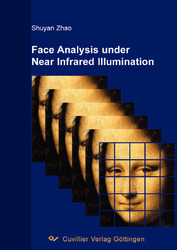| Areas | |
|---|---|
| Serie de libros (96) |
1378
|
| Nachhaltigkeit |
3
|
| Gesundheitswesen |
1
|
| Letra |
2363
|
| Ciencias Naturales |
5406
|
| Matemática | 229 |
| Informática | 319 |
| Física | 980 |
| Química | 1363 |
| Geociencias | 131 |
| Medicina humana | 243 |
| Estomatología | 10 |
| Veterinaria | 108 |
| Farmacia | 147 |
| Biología | 835 |
| Bioquímica, biología molecular, tecnología genética | 121 |
| Biofísica | 25 |
| Nutrición | 45 |
| Agricultura | 1004 |
| Silvicultura | 201 |
| Horticultura | 20 |
| Ecología y conservación de la tierra | 148 |
| Ciencias Ingeniería |
1791
|
| General |
98
|
|
Leitlinien Unfallchirurgie
5. Auflage bestellen |
|
Erweiterte Suche
Face Analysis under Near Infrared Illumination (Tienda española)
Shuyan Zhao (Autor)Previo
Indice, Datei (25 KB)
Lectura de prueba, Datei (300 KB)
This dissertation focuses on developing a facial analysis system under near infrared
illumination (NIR). The use of near infrared imagery alleviates the difficulty of illumination
variation for face recognition, and enables the system to work under changeable
ambient lighting conditions.
At first a multi-modal database for person authentication under near infrared illumination
is built, which provides the research community the possibility to test their
algorithms for audio- and video-based person authentication under NIR. So far audio
and video data from 74 subjects have been recorded. Ground truths, namely coordinations
of eyes and lip corners, as well as six distinct viseme (mouth shape) classes are
manually collected. All the experiments in this work are carried out on this database.
The main part of the face analysis system consists of three key modules: eye detection,
feature extraction, and classification. To achieve an automatic face recognition
system, reliable detection of eyes is crucial. On the one hand eyes are the most salient
and stable facial features; on the other hand eye positions are generally used to align and
normalize the face. The algorithm presented in this work achieves robust eye detection
under NIR. In most cases this algorithm makes use of the bright pupil effect and relies
on a novel thresholding algorithm to select pupil candidates. To increase the robustness
against eyeglasses and pupil intensity when selecting pupil candidates, the symmetry
transform is incorporated. An appearance model is then employed for eye verification.
This dissertation proposes Discrete Cosine Transform (DCT)-based features for face
recognition. A multi-block fusion scheme is put forward, whose aim is to easily combine
global and local features for face recognition. This scheme can be utilized with any
algorithm to improve the performance in general. The DCT based features have been
continuously optimized. At first blockwise DCT, which emphasizes local information,
outperforms holistic DCT. AdaBoost algorithm is then employed to extract features,
which yields better results than blockwise DCT. A novel boosting algorithm, CorrAdaBoost,
is proposed, which incorporates correlation with the original AdaBoost algorithm.
CorrAdaBoost reduces the redundancy between selected features and is more
effective than AdaBoost. The cascaded CorrAdaBoost further improves the performance
and efficiency. The proposed normalization strategy generally improves the performance
of every kind of features.
This work evaluates different classification approaches, namely nearest neighbor,
nearest center, Linear Discriminant Analysis (LDA), and Support Vector Machine (SVM).
Among all approaches, LDA yields the best performance, then comes the nearest neighbor
classifier based on the Manhattan distance.
This work realizes video-based recognition using the proposed approaches of face
representation and classification. An exemplar learning algorithm is implemented, which
is a direct way to build the probabilistic representation of each individual from a gallery
video. A natural way to make use of multiple frames is temporal integration. Three
schemes of temporal integration, i. e. the max rule, the majority voting rule, and the
probabilistic voting rule are carried out. A simultaneous tracking and recognition approach
based on condensation algorithm is adopted for true video-based face recognition.
Exhaustive experiments have been conducted, a great deal of results demonstrate the
effectiveness of the proposed algorithms.
| ISBN-10 (Impresion) | 3867277575 |
| ISBN-13 (Impresion) | 9783867277570 |
| ISBN-13 (E-Book) | 9783736927575 |
| Formato | A5 |
| Idioma | Inglés |
| Numero de paginas | 158 |
| Edicion | 1 Aufl. |
| Volumen | 0 |
| Lugar de publicacion | Göttingen |
| Lugar de la disertacion | TU Hamburg-Harburg |
| Fecha de publicacion | 08.10.2008 |
| Clasificacion simple | Tesis doctoral |
| Area |
Informática
|








